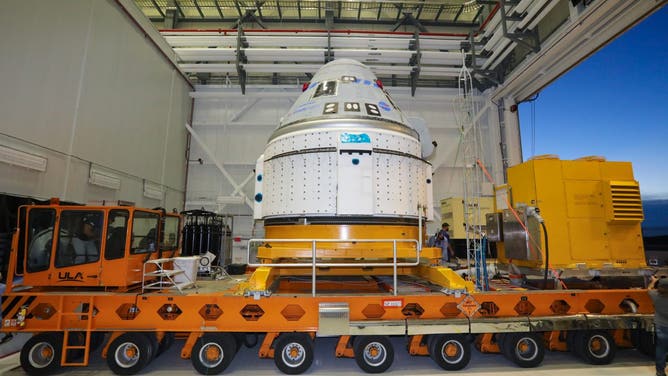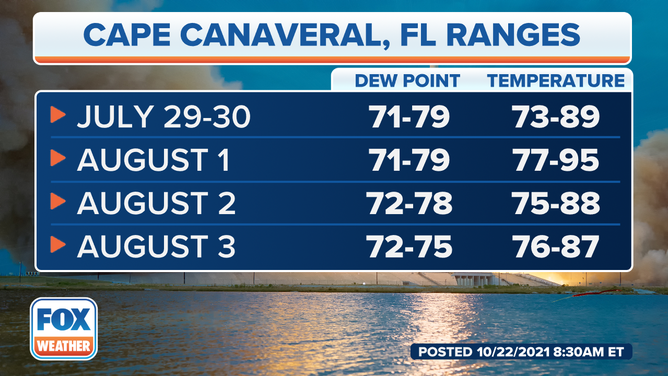Boeing investigates if Florida humidity factored into Starliner spacecraft valve issue
Launch now planned for first half of 2022

Boeing’s Starliner spacecraft returned Aug. 19, 2021, from the United Launch Alliance Vertical Integration Facility to the Commercial Crew and Cargo Processing Facility at NASA’s Kennedy Space Center in Florida, where teams will work to diagnose and resolve a valve issue detected during the Aug. 3 launch attempt of NASA Boeing’s Orbital Flight Test-2.
(Boeing)
CAPE CANAVERAL, Fla. – Boeing's astronaut spacecraft, the CST-100 Starliner, won't fly until the first half of 2022 after a sticky valve issue continues to plague the private company contracted to launch NASA astronauts to the International Space Station.
In an update last week by Boeing and NASA managers, officials said engineers are still working to get to the bottom of the valve issue that delayed the company's most recent attempt to conduct an uncrewed orbital flight test to the International Space Station.
The company has twice attempted to make the journey.
A December 2019 attempt made it to orbit after launch, but the spacecraft returned to Earth 48 hours later because of a computer timing error. Most recently, Boeing attempted to launch Starliner to the space station on Aug. 3. Early in the countdown teams detected that not all valves in the spacecraft's abort system were in the proper configuration needed for launch. The attempt was called off and the company has been working to resolve the problem ever since.
"At that time, we had 13 of the 24 valves, which would not cycle for us," Boeing Space and Launch Chief Engineer Michelle Parker said. "And at that time, we determined that we would not be launching that day."
After troubleshooting in the rocket hangar, teams were able to clear nine valves, but four remained stuck, according to Parker.
Boeing and the valve maker Aerojet Rocketdyne have narrowed in on a potential cause: moisture reacting with spacecraft chemicals.
"The team really honed in on the most probable cause of an interaction between the oxidizer that is in the system and water or humidity in the valves as well, combining to form nitric acid and corrosion products, which then contributed to the sticking of the valves," Parker said.
Now, more than two months later the fuel has been cleared from the spacecraft and three of the troublesome valves are being sent to NASA's Marshall Spaceflight Center to undergo a CT scan, similar to what is used in the human medical field.
Boeing is evaluating whether humidity could have been part of the problem to cause the valves to corrode.
Florida's humidity is notoriously high in the summer and in the days before the August launch attempt, there were a number of thunderstorms around the Cape Canaveral Space Force Station launch site.
The investigation entails attempting to recreate the humid conditions ahead of launch to determine if that was part of the problem.
Boeing Commercial Crew Program vice president John Vollmer said it's possible the valves were picking up moisture from the environment.
The ULA Atlas V rocket and Boeing spacecraft were rolled out to the launchpad on July 29 and then back into the hangar on July 30 due to thunderstorms in the area. The rocket was brought back out to the launchpad on Aug. 2.
Weather data from July 29 through Aug. 3 shows Cape Canaveral Space Force Station was experiencing high dew points in the mid to even upper 70s.
"Dew points are a measure of moisture content -- it's the temperature at which the air would become saturated," FOX Weather meteorologist Scott Sistek said. "Since warm air holds more moisture than cooler air, higher dew points mean greater amounts of moisture in the air. Dew points in the upper 70s are among the higher readings you'll see in Florida."

The high and low dew points and temperatures at Cape Canaveral Space Force Station when Starliner was rolled out to the launchpad, back into the hangar and then back out to the launchpad.
(FOX Weather)
Investigators said there is one vent hole that could have allowed moisture to seep in and the team has since patched that weak spot.
"We are going to try and replicate the conditions that these values went through," Vollmer said, adding testing will be conducted in New Mexico "to understand what these valves went through."
The spacecraft pad abort test was conducted in New Mexico before the spacecraft was brought back to Florida for liftoff.
When Boeing does complete the OFT, if all goes well, there will then be a flight test to the space station with astronauts on board.
NASA's commercial crew program manager Steve Stitch said as long as the data is good from OFT the crewed flight test (CFT) would happen depending on the ISS schedule.
CFT could happen by the end of 2022, estimated Vollmer, but first Boeing must get through this first flight test.
The Starliner was selected by NASA to be part of the agency's commercial crew program. Competitor SpaceX's Crew Dragon was also awarded a contract and has since flown three crews of astronauts to the space station with a fourth planned Oct. 31.
Last month, NASA announced two astronauts assigned to fly on Starliner will now fly with SpaceX after extended delays with the other spacecraft.